Physical Address
304 North Cardinal St.
Dorchester Center, MA 02124
Aqueous misdirection, or malignant glaucoma, is a rare form of glaucoma that typically occurs postoperatively in patients with primary angle closure and is characterized by elevated intraocular pressure with a diffusely shallow or flat anterior chamber despite a patent iridotomy.
Shallowing or flattening of both the central and peripheral anterior chamber despite patent iridotomy.
Typically associated with markedly elevated intraocular pressure.
Usually occurs after intraocular surgery.
Secondary angle-closure glaucoma.
Worsened by miotics and relieved by cycloplegic agents.
Involves some degree of misdirection of aqueous humor into the vitreous cavity.
Supraciliary or suprachoroidal effusion, if present, is very small.
Aqueous misdirection—also known as malignant glaucoma or ciliary block glaucoma —is a rare form of glaucoma that typically follows intraocular surgery in patients with primary angle closure (PAC) and primary angle-closure glaucoma (PACG). Although classically occurring after incisional glaucoma surgery, it may also develop after routine cataract surgery, initiation of miotic agents, or ciliary body swelling. It may be difficult to make an accurate diagnosis, particularly in the early stages.
Aqueous misdirection occurs in approximately 2%–4% of patients who undergo incisional glaucoma surgery for PACG. Generally, aqueous misdirection develops in the early postoperative period after trabeculectomy, tube-shunt surgery, or cataract extraction, although it can occur months to years later. Less common causes include initiation of miotic therapy, laser iridotomy, laser cyclophotocoagulation, posttrabeculectomy bleb needling or laser suture lysis, laser capsulotomy, pars plana vitrectomy, or spontaneous development. Patients with axial hyperopia or some degree of angle closure at the time of surgery are at increased risk.
Originally described by von Graefe as malignant glaucoma in 1869, aqueous misdirection has become the more accepted term. In 1954, Shaffer and Hoskins suggested that the etiology for this disease state is posterior misdirection of aqueous flow into or behind the vitreous body, in the setting of a relatively impermeable hyaloid membrane; the subsequent increase in vitreous volume results in diffuse shallowing of the anterior chamber and an increase in intraocular pressure (IOP). Although this description is generally accepted, the pathogenesis of aqueous misdirection is somewhat controversial and may be multifactorial. Epstein and coauthors have demonstrated vitreous hydration as a basic etiology, and Quigley and colleagues have suggested that choroidal thickening may result in a forward rotation of the ciliary body and choroid, causing secondary angle closure. Vitreous hydraulic conductivity, which is influenced by the permeability of the vitreous to the transit of ionic compounds through its substance, may also play a role. Although the exact mechanism for aqueous misdirection is unclear, the anatomic relationship among the ciliary body, lens, and anterior hyaloid is thought to play a role.
Aqueous misdirection is typically unilateral, given its occurrence after surgery. Cycloplegic agents shift the lens–iris diaphragm posteriorly and are administered after glaucoma filtering procedures to prevent aqueous misdirection; their withdrawal can precipitate an episode. Predisposing features include decreased axial length, narrow or closed angle, swelling and inflammation of the ciliary processes, and mitotically induced forward movement of the lens–iris diaphragm with anterior rotation of the ciliary body. Women have a higher incidence of angle closure and are at increased risk of aqueous misdirection. Notably, the majority of reported cases of aqueous misdirection occur in Caucasian populations rather than Asian populations, even though PACG is more prevalent in Southeast Asia and China. This may potentially indicate a different etiology of angle closure in Caucasian versus Asian populations.
A red, painful eye develops after intraocular surgery, typically for angle-closure glaucoma. Decreased vision and a significant myopic shift may be present. Slit-lamp examination ( Fig. 10.18.1 ) reveals a unilaterally shallow or flat anterior chamber, both centrally and peripherally, with no iris bombé. A high index of suspicion is necessary to make the appropriate diagnosis because initially, the IOP may be minimally elevated. The key is that the anterior chamber is axially (centrally) shallow. If an attempt is made to re-form the anterior chamber postoperatively through the paracentesis site using a viscoelastic substance, a great deal of posterior resistance may be noted, the anterior chamber may deepen poorly, and the IOP may rise substantially.

Become a Clinical Tree membership for Full access and enjoy Unlimited articles
If you are a member. Log in here